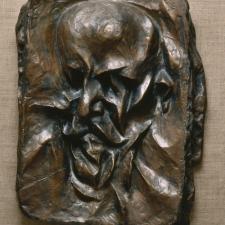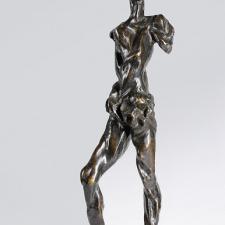Sculptor Otto Gutfreund (1889-1927) is one of the most important European artists of the early 20th century. His works are divided into two eras which differ in formal principle and social acceptance. The first is from the 1910s, when, based on the principles of Cubism, he designed new spacial sculptural forms. The second, civilist era is a part of modern 1920s realism and, in contrast to the individualist modern art of the pre-war period, grew with public commissions. The current exhibition, however, does not adhere to this traditional style delineation; on the contrary, it strives to connect these two detached spheres. The focus is on three main sculptural types – relief, figure and portrait/bust – and on drawings associated with the chosen works. The intention is to emphasise the continuity in Gutfreund’s creations, despite the external differences in his work.
1. Relief
Relief is a specific sculptural technique similar in character to painting or drawing. It is a “sculpture on a flat surface”. From the very beginning, Gutfreund refused to imitate reality, preferring to assert spirituality and the dematerialisation of sculpture, to which relief was the first step. After his relief the Brickmakers (1911), he began to expressively dynamize abstract shapes, climaxing in the relief Concert (1912-1913). His drawings from the same period were designed in the same way. He returned to relief in the 1920s with official commissions, placing more emphasis, however, on intelligibility and ornamentation. Thematically he focused on everyday life and work, which had been foreshadowed by the Brickmakers. The journey towards the definitive appearance of these works can be seen in the preparatory drawings.
2. Figure
Early on, Gutfreund began to release himself from classical, traditional depictions of figure. Firstly, he expressively deformed the sculpture, later dynamically breaking the surface with sharp cuts and protruding edges. Finally, he opened the figure into the space, creating volume with the imaginary movement of the surfaces. The ultimate form of this approach is the wooden sculpture Sitting Woman (1916); this new structural principle can also be found in a series of drawings. Even in the 1920s Gutfreund did not forsake the geometry of sculpture; in civilist sculptures (mainly in studies) the interconnection of simple shapes (cones, cylinders, spheres) can be seen. More distinct geometry is apparent at the very end of Gutfreund’s untimely closed creative career (Sitting Woman II, 1927)
3. Portrait / Bust
Gutfreund focused on portrait at the beginning of his artistic career and returned to it with a new intensity in his works from the 1920s. In the interim years of 1912-1915, however, he set this aside to concentrate on busts. He based his work on a composition of fragments, from which – as in figure – he drew abstracted constructions of pervading flat surface forms (Head with a Hat, 1913-1914). He also sought compositional design in a series of drawings in which he layered geometric fragments composing a face. The simplification of shapes and focus on the flat surface led to outstanding “minimalist” linear drawings that are an extreme reduction or abstraction of the chosen theme.
The artworks are on loan from the following collections:
Moravian Gallery in Brno
Olomouc Museum of Art
National Gallery in Prague
Regional Art Gallery in Liberec
North Bohemian Gallery of Fine Arts in Litoměřice
Museum of Decorative Arts in Prague
Jewish Museum in prague
Private collection
The exhibition takes place at the occasion of 90 years since Otto Gutfreund's death (he drowned in the Vltava River in Prague under unexplained circumstances at the age of 37 on 2nd June 1927).
The partner of this exhibition is the National Gallery in Prague.
We are grateful to the following institutions for their support:
![]()
![]()
|
|









